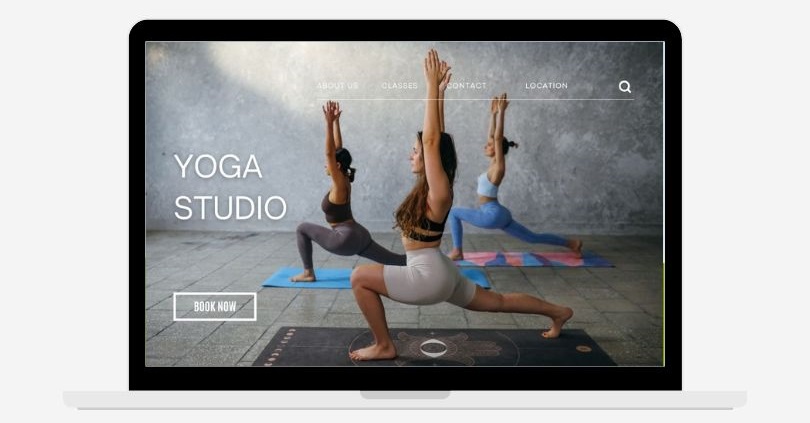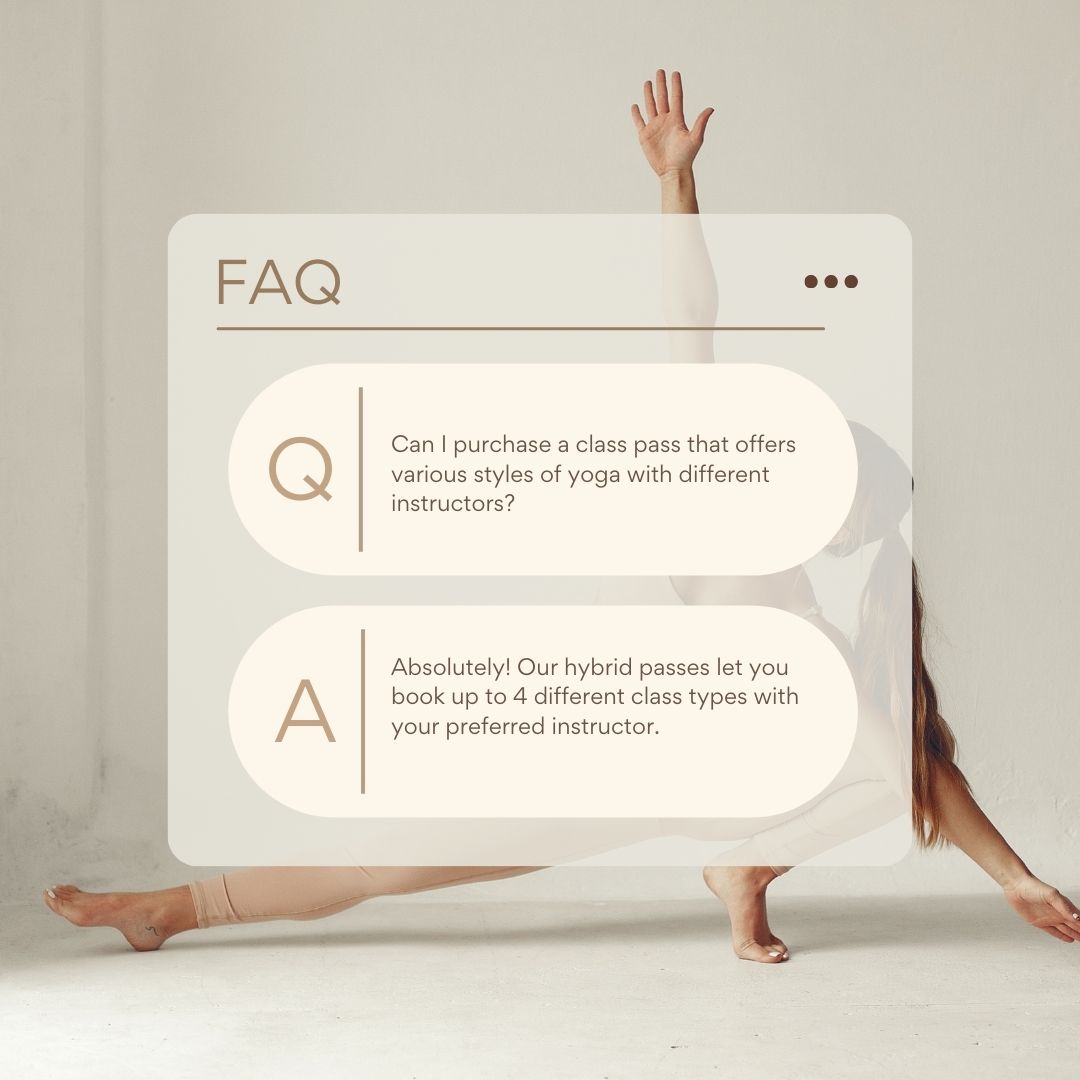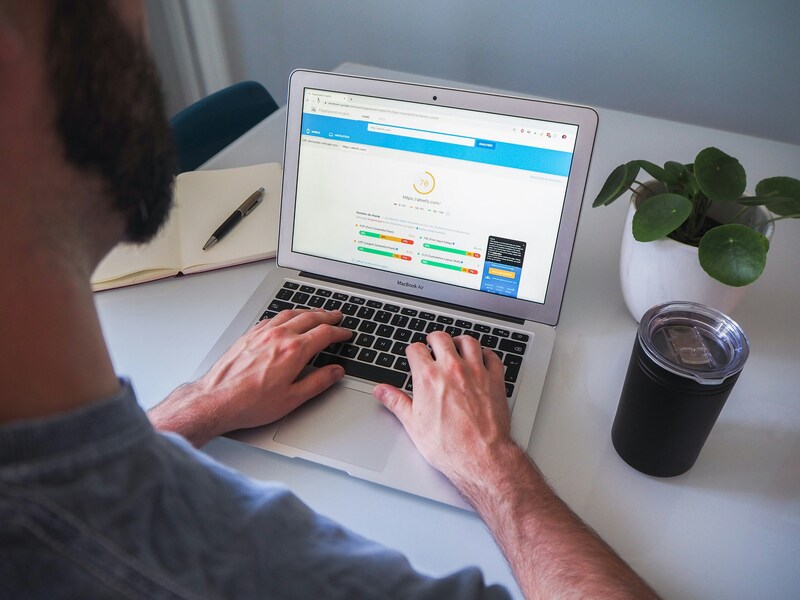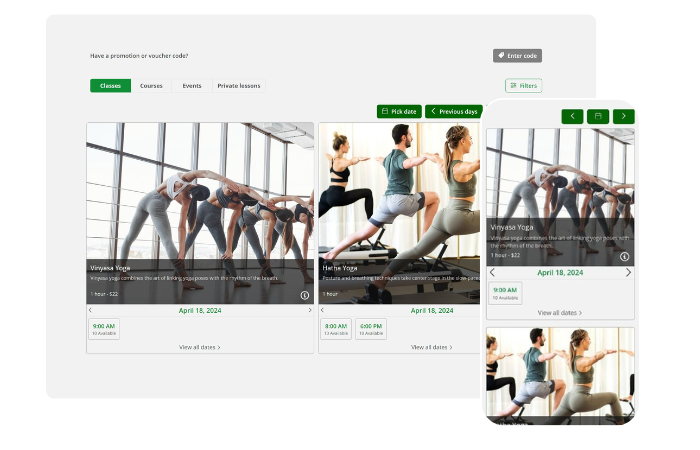
The Complete Guide to SEO for Yoga Website
A robust online presence is simply crucial for yoga studios in this digital era. It is important to achieve a high ranking on platforms such as Google, as the majority of potential clients will initially locate your studio through a search engine. Search engine optimization (SEO) is involved in this process.
SEO helps yoga studios attract more clients by improving your website’s visibility on search engines. When done right, SEO ensures that your website appears at the top of search results when users look for services like yours. For example, when people search for “yoga classes,” a well-optimized website will get more traffic, bookings, and, eventually, loyal customers.

In this SEO tutorial for yoga studios, we’ll cover:
- Understanding SEO principles for yoga studios
- How to conduct keyword research
- Off-page and on-page optimizations
- Local SEO techniques
- Technical aspects of Yoga SEO
- Proven strategies for increasing website traffic via content creation
With the knowledge you get from this article, you will be able to increase the number of people who visit your yoga company website, which will lead to more customers and larger profits. First, we’ll discuss the rundown on search engine optimization (SEO) and how it might benefit your yoga studio.
Yoga Websites: What Is SEO And How Does It Work?
Search Engine Optimization (SEO) is the practice of increasing a website’s ranking and visibility in search engines such as Google and Bing. For yoga studios, SEO is crucial because it helps potential clients find your website when they search for terms like yoga classes near me or yoga studios. A well-optimized site appears higher in search results, generating traffic and, eventually, new client sign-ups.

Concisely, SEO involves the optimization of a website’s technical components and content to ensure that search engines can comprehend and rank the site.
Important Factors That Influence Search Engine Rank
On-Page SEO
On-page SEO is the process of optimizing individual pages of your yoga website for specific keywords, such as “yoga classes” or “yoga studio”: On-page factors include:
- Keyword Placement: Make natural use of target keywords in text, headers, and titles. For instance, ensure that the headline of your webpage includes terms such as “yoga courses” or “yoga classes.”
- Meta Descriptions: These short descriptions appear in search results underneath your link. Write concise, compelling descriptions that encourage clicks.
- Content Quality: Search engines like well-written, relevant content. Your blog entries should provide useful information while also using the target keywords. For example, you may provide recommendations on yoga for beginners that are optimized for keywords such as “Yoga for beginners.”
- URL Structure: Clean, readable URLs that represent the page’s content (i.e., “/yoga-classes” rather than “/page123”) can improve results.
Off-Page SEO
Off-page SEO is about activities that take place outside your website but still affect your rankings.
- Backlinks: These are hyperlinks from other websites that direct visitors to your yoga website. The more backlinks you have, the better; nevertheless, the quality and relevancy of the website giving links is also vital. Partnering with relevant websites, directories, or blogs can help.
- Social Signals: Social media activity indirectly influences SEO rankings. When your content is shared, liked, or commented on across platforms such as Facebook, Instagram, or Pinterest, your yoga website’s exposure and traffic can both improve.

- Local Listings and Citations: Accurately listing your yoga studio on local directories (such as Yelp, Google Business, or other fitness directories) is essential for local SEO. Positive reviews on these platforms are also critical.
Technical SEO
Technical aspects also affect how well search engines rank your site:
- Mobile Friendliness: A responsive yoga website that works well on smartphones is essential since many users search on mobile devices.
- Site Speed: Faster-loading pages rank higher. Compress images and reduce unnecessary code to improve load times.
- Security: Make sure your website uses HTTPS, as search engines favor secure sites.
In conclusion, understanding both on-page and off-page SEO, as well as technological upgrades, is critical to improving SEO for yoga studios and attracting local customers to your courses.
SEO For Yoga Website: A Step-by Step Guide
This section will provide detailed, step-by-step guidance for running a successful SEO campaign for your yoga website. Let’s begin with the first step.
Step 1: Keyword Research
A comprehensive keyword research is a necessary component of any SEO plan. Targeting the proper keywords allows you to connect with individuals who are actively looking for what you provide (yoga services in your area).
Here’s how to get started:
- Use keyword tools: Free tools like Google Keyword Planner and Ubersuggest can help you find keywords related to yoga SEO. These platforms offer data on search volume and competition levels, so you can prioritize the most effective keywords.
- Target long-tail keywords: Focus on long-tail keywords (they tend to be less competitive), such as “yoga studio near [your neighborhood]” or “beginner yoga classes in [your city],” rather than solely on generic terms like “yoga.”
- Incorporate local SEO: Include your studio’s location in your keywords to aid in local SEO for yoga studios. Using phrases like “yoga studios in [city]” will help you get exposure among local customers.
By carefully choosing the right keywords, you lay the groundwork for a successful SEO strategy that brings traffic to your yoga website.
Step 2: On-Page Optimizations
On-page optimization is a critical component of yoga studio SEO success. By optimizing the various components of your website, you can help search engines crawl, index, and interpret your content better.

Focus on the following critical on-page components:
Craft SEO-friendly title tags and meta descriptions:
- Use primary keywords like “SEO for yoga website” and “yoga studios SEO” in your title tags and meta descriptions.
- Keep title tags under 60 characters and meta descriptions between 150 and 160 characters.
- Compose concise and compelling descriptions that motivate searchers to click.
Use headers (H1, H4) effectively:
- Use headers to structure your content, improving readability and SEO.
- The main page title should be an H1 element that contains your core keyword (for example, “SEO for Yoga Studios”).
- Use H4 or H5 tags for subheadings to arrange information and incorporate secondary keywords as needed.
Optimize images with ALT text:
- All images on your website should have ALT text describing the image and include relevant keywords like “yoga studio” or “yoga classes.”
- ALT text not only helps with SEO but also improves accessibility for visually impaired users.
Internal linking:
- Link to additional relevant pages on your website (your class schedule, price page, blog entries, etc.).
- Internal links assist search engines in comprehending your site’s structure and encourage users to explore other pages.
Optimizing these on-page elements ensures your yoga website is user-friendly and search engine optimized, helping it rank higher and attract more clients.
Step 3: Create High-Quality Content
Creating high-quality content is essential for boosting your yoga website’s SEO. Valuable content not only attracts potential clients but also maintains their interest, thereby establishing your studio as an authority in the yoga community.

The subsequent strategies are intended to facilitate the creation of proficient content:
Develop informative blog posts and service pages:
- Write blog posts that answer typical queries or problems that yoga practitioners have. Topics can include “The Benefits of Yoga for Beginners” or “How to Choose the Right Yoga Class.“
- Create extensive service pages for each class you provide, outlining the advantages and what customers may anticipate.
Target keywords naturally within your content:
- Incorporate major keywords such as “yoga tips” and “yoga benefits” effortlessly into your article.
- Aim for natural flow; avoid keyword cramming, which may hurt your readability and SEO results.
Create FAQs, yoga tutorials, and local content:
- Develop an FAQ section addressing common inquiries about your studio, classes, and membership options.

- Share yoga tutorials that can guide clients through specific poses or routines, adding value and encouraging return visits.
- Local content, such as blog postings on neighborhood events or partnerships with nearby wellness companies, may help to increase relevance and attract local search traffic.
Follow best practices for content length and readability:
- Longer posts (1,500+ words) tend to rank better on Google because they provide more comprehensive content and allow for natural keyword usage, including long-tail keywords.
- Use short paragraphs, bullet points, and subheadings to enhance readability and break up large blocks of text.
- Consider using readability tools to verify that your information is accessible to a wide audience.
Focusing on high-quality, valuable content will help you boost your yoga website’s SEO, attract more visitors, and turn them into devoted customers.
Step 4: Local SEO
Because yoga studios naturally cater to local customers, local SEO is essential. By optimizing your web presence for local searches, you may attract new clients and increase your studio’s exposure in search results.
Here’s how to develop successful local SEO strategies:
Set up and optimize your Google Business listing:
- Claim and verify your Google Business listing to ensure your studio appears in local search results and on Google Maps.
- Make sure your business name, address, phone number, website, and operating hours are accurate and up to date.
- Add high-quality images of your studio and yoga classes to make your listing more appealing.

Encourage customers to write good reviews:
- Client reviews play a significant role in local SEO rankings. Encourage pleased customers to post reviews on your GMB page, since more good feedback enhances business trustworthiness.
- Respond to reviews promptly, thanking clients for their feedback or addressing any concerns professionally.
Use location-based keywords:
- Include local keywords, for example, “yoga studio in [city name]” throughout your website and Google Business listing.
- Integrating these local keywords into your content’s body, meta descriptions, and title tags can also attract local search traffic.
Build local backlinks:
- Aim to get backlinks from relevant websites and businesses in your area. Collaborate with complementary companies including health food shops, fitness facilities, and wellness centers.
- Offer to write guest posts for local lifestyle or wellness blogs. Share yoga techniques, health information, or event notices with a link back to your website.
- Support local charity events, festivals, and health fairs. Most event organizers will include sponsors on their websites, including connections to your studio.
Local citations:
- Submit your yoga studio to wellness directories and reputable local business directories.
- Check out Yelp, the website of your local chamber of commerce, and TripAdvisor, just to name a few.
- Name, Address, Phone Number (NAP) details should be the same throughout all listings for your studio.
Step 5: Make Your Website Mobile-Friendly
It is imperative to optimize your yoga website for mobile users, not only for the sake of SEO but also for user experience. With more and more people now exclusively browsing the internet on mobile devices, Google now prioritizes mobile-friendly websites in its SERPs.
Here’s how to verify that your website is optimized for mobile:
Importance of a mobile-friendly design for SEO:
- A mobile-friendly design implies that your website adapts effortlessly to multiple screen sizes, providing a smooth experience on smartphones and tablets.
- Google employs mobile-first indexing, which means it prioritizes the mobile version of your site when ranking pages, making mobile optimization critical for yoga SEO.
Ensure fast load times and responsive design:
- Slow load times on mobile devices can cause visitors to leave your site quickly, negatively impacting both SEO and user experience. Compress images, minify code, and utilize efficient hosting to boost performance.

- A responsive design adjusts your site’s layout to fit any screen size, keeping your content readable and easy to navigate.
Tools to test mobile performance:
- Use Google’s Mobile-Friendly Test to check whether your site meets mobile usability standards. This tool highlights any issues that could affect how your site performs on mobile.
- PageSpeed Insights is another tool to analyze how fast your website loads on mobile and offers specific recommendations for improvement.
By optimizing your yoga website for mobile, you provide a better user experience and boost your SEO performance, resulting in more mobile visitors to your studio.
Step 6: Build High-Quality Backlinks
Backlinks are one of the most essential ranking elements for SEO, and creating high-quality backlinks will greatly boost your yoga studio’s search engine visibility. Google regards a backlink from a reputable website as a “vote of confidence,” suggesting that your website is trustworthy and authoritative.
The more high-quality backlinks your website has, the more likely it is to rank higher in search results for relevant keywords like “yoga SEO” or “SEO for yoga studios.” These links also help drive referral traffic, bringing potential clients to your yoga studio from other trusted sites.
Strategies for building backlinks:
- Guest posting: Contact well-known yoga blogs/websites and propose that you contribute a guest post. This allows you to include a backlink to your website while contributing valuable content.
- Influencer partnerships: Collaborate with yoga influencers in your area. They may be able to feature/review your classes or products on their blogs or social media profiles, linking your website.

- Submit to directories: List your yoga studio in relevant online directories (i.e., wellness, fitness directories.)
Engaging with local businesses and partners for link-building opportunities:
- Collaborate with local businesses: Partner with nearby wellness centers, gyms, or health food stores to cross-promote services. These businesses can link to your site from their “partners” or “resources” page, providing local relevance for SEO.
- Host community events: Organize yoga workshops or charity events in collaboration with local businesses. Ask them to promote the event on their websites with links back to your studio.
- Sponsorships: Support charities or neighborhood events and request a hyperlink from the event’s official website.
Building high-quality backlinks from relevant sources can help your yoga website establish authority, attract more traffic, and enhance its search engine ranks over time.
Step 7: Use Social Media to Boost SEO
Social media participation will not immediately help your yoga website’s search engine optimization (SEO), but it will increase traffic and visibility, which will indirectly benefit your SEO.
Leveraging social media platforms to drive traffic:
- Social media platforms like Instagram, Facebook, and Pinterest are excellent tools for promoting your yoga website. Share blog entries, class schedules, and other content with links back to your website to encourage followers to visit.
- Posting visually appealing images of your classes, yoga poses, or events with links to your website can bring potential clients directly to your studio’s page.

Importance of consistent posting and sharing valuable content:
- Regular posting helps keep your audience engaged and encourages more shares and interactions. This social activity can drive traffic to your website, which signals search engines that your site is valuable and relevant.
- Share a variety of content, including yoga tips, tutorials, event updates, and client testimonials. The more engaging your content is, the more likely followers will share it, resulting in more traffic.
How social media signals can indirectly influence SEO:
- When your content gets shared on social media, it increases brand awareness and the chances of earning backlinks from other sites. Increasing the number of shares and visits to your website can result in improved SEO performance over time.
- Social media profiles can also appear in search engine results, which increases your overall online presence. Having active social profiles that link to your website boosts your credibility.
Using social media consistently to promote your yoga content can not only increase website traffic but also amplify your online presence, indirectly boosting your yoga studio’s SEO over time.
Step 8: Optimize for Voice Search
Voice search is becoming an increasingly significant component of SEO as more people use voice-activated devices like smartphones, smart speakers, and virtual assistants (i.e., Siri, Google Assistant) to locate local businesses. For yoga studios, optimizing your website for voice search will help you find more potential clients who use this technique.
Here is how to optimize for voice searches:
Growing importance of voice search in SEO:
- Nearly 50% of searches are now conducted through voice, and this trend is expected to grow. Voice search tends to prioritize local results, making it essential for yoga studios targeting nearby customers.
- Optimizing your site for voice search improves your chances of being found by potential clients asking for directions, recommendations, or specific services.
Target conversational queries and long-tail keywords:
- Voice searches are more conversational and often take the form of questions. Instead of short keywords like “yoga studio,” voice search users might ask, “Where’s the best yoga studio near me?”

- Focus on targeting long-tail keywords that resemble these natural, spoken phrases. Create content that answers common questions related to yoga and your services, such as “How can beginners get started with yoga?” or “What are the benefits of hot yoga?”
Optimize for local voice searches:
- Voice search is especially useful for local SEO. To capture more local traffic, make sure your business information (name, address, phone number) is accurate across your website, Google My Business, and directories.
- Use keywords like “find a yoga studio near me” or “best yoga classes in [city]” to help your site appear when users ask location-specific queries.
Your yoga studio can remain competitive by focusing on voice search optimization, which ensures that potential clients can simply locate your business while searching using voice commands.
Step 9: Improve Website Loading Speed
Website loading speed is critical for both SEO rankings and user experience. Google emphasizes fast-loading websites because they provide a better user experience, and slow sites tend to have greater bounce rates, which means visitors leave before the page finishes loading. This directly impacts how well your yoga website ranks in search engine results.

Here’s how to optimize your site’s speed for better SEO:
Why website speed affects SEO rankings:
Google considers page speed as a ranking factor, especially for mobile searches. Slow websites tend to rank lower because they frustrate users, leading to fewer interactions and higher bounce rates. A faster website keeps visitors engaged, reducing bounce rates and boosting overall SEO performance.
Tools to test website speed:
Tools like Google PageSpeed Insights, GTmetrix, and Pingdom can help you analyze your website’s speed and provide recommendations for improvement. These tools give a detailed report on what’s slowing down your site and offer specific solutions.

To enhance the search engine optimization (SEO) of yoga websites and ensure a seamless user experience, strive for a loading time of 2 seconds or less.
Best practices for improving load times:
- Image compression: One of the primary causes of sluggish load times is the use of large images. Compress images without losing quality to reduce their size and speed up your site. Tools like TinyPNG or ImageOptim can help with this.
- Caching: Implement browser caching to store elements of your site, like images or scripts, in users’ browsers so that they don’t have to load everything from scratch every time they visit your page.
- Minimize CSS and JavaScript: Reducing unnecessary code or using asynchronous loading ensures that essential elements load quickly.
By focusing on improving your website’s loading speed, you not only enhance user experience but also boost your yoga website’s SEO rankings, helping to attract and retain more clients.
Step 10: Monitor and Track SEO Performance
Monitoring and tracking your SEO performance is essential for understanding how well your yoga studio website is ranking and what improvements are needed. Regular monitoring enables you to identify growth opportunities and optimize your strategies by utilizing actual data.
Here’s how to stay on top of your SEO performance:
Using tools like Google Analytics and Google Search Console:
- Google Analytics helps track overall website traffic, user behavior, and which keywords or pages are bringing visitors to your site. This data allows you to understand which content resonates with your target audience and which pages want development.
- Google Search Console allows you to monitor keyword rankings, click-through rates (CTR), and indexation issues. It shows you how your website appears in Google search results and warns you to any technical difficulties that may be harming your yoga studio SEO.

Regularly reviewing website performance and making required adjustments:
- SEO is not a “set it and forget it” process. You need to regularly review your website’s performance to identify what’s working and what’s not.
- Check your keyword rankings to see how well your content is performing for important terms like “yoga classes” or “ yoga studio.” If certain pages are underperforming, consider updating the content, improving on-page SEO, or acquiring more backlinks to those pages.
Importance of continuous SEO improvement based on data:
- SEO is constantly evolving, and it’s crucial to adjust your strategy based on the data you collect. For example, if the data shows that visitors are quickly abandoning a given page, this could indicate that the material needs to be improved in terms of relevancy or engagement.
- Data-driven changes, such as fine-tuning your keyword approach, increasing page load speed, or adding more internal links, can have a big impact on your site’s search engine ranking.
Consistently monitoring your SEO performance and making data-informed decisions guarantees that your yoga website remains competitive and continues to attract new clients through search engines.
How Bookeo Can Support Your Yoga Studio’s SEO and Growth
Although it is crucial to implement SEO strategies in order to increase traffic to your yoga website, it is equally crucial to have the appropriate tools in place to manage your studio’s operations. Here is where Bookeo can make a significant impact. A booking system is not the only feature that Bookeo provides; it also includes integrated features that can improve your overall marketing efforts, such as SEO.

Here’s how Bookeo can help:
- Optimized Online Booking System: A well-structured and easy-to-navigate booking system can improve user experience. Bookeo’s online appointment scheduling system integrates seamlessly with your website, allowing clients to book classes directly. This keeps visitors on your site longer and reduces bounce rates, which can positively impact SEO.
- Automated Email Campaigns: Bookeo’s integration with marketing tools allows you to automate email campaigns to re-engage past clients and attract new leads. This helps keep your yoga studio top of mind, driving repeat visits to your website—another signal that boosts SEO.
- Google Analytics Integration: With Bookeo, you can easily integrate with Google Analytics, enabling you to track which marketing efforts are driving traffic and bookings.
Incorporating a platform like Bookeo into your yoga studio’s operations can streamline your booking process, enhance your client management, and indirectly support your SEO efforts by improving user engagement and site performance.
Conclusion
It is imperative to enhance the search engine optimization (SEO) of your yoga studio website in order to attract additional clients and distinguish yourself in a competitive market. By following the steps outlined—like optimizing on-page elements, improving website speed, and creating high-quality content—you’ll enhance your online visibility and draw in more traffic.
Bookeo’s features, such as its seamless booking system, automated marketing tools, and integration with Google Analytics, not only improve user experience but also indirectly support your SEO by driving engagement and repeat visits.
Take the time to invest in both your SEO and the right tools, and you’ll see sustained visibility, growth, and success for your yoga studio.

